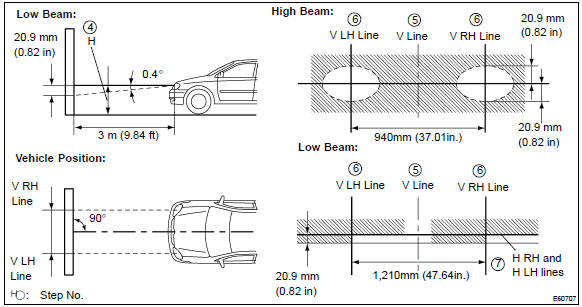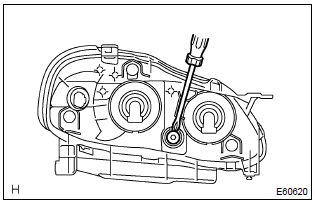Toyota Corolla (E120): Adjustment
1. Headlight aim only
- place the vehicle in the following conditions.
- The area around the headlight is not deformed.
- The vehicle is parked on a level surface.
- Tire inflation pressure is in the specified value .
- A driver is in the driver’s seat and the vehicle is in a state ready for driving (with a tank full).
- The vehicle has been bounced several times.
- check the headlight aiming.
- Prepare a thick white paper.
- Stand the paper perpendicular to the ground at the position 9.84 Ft away from the headlights.
- Ensure that the center line of the vehicle and the paper face forms a 90–degree angle as shown in the illustration.
- Draw a horizontal line (h line) on the paper, showing where the headlights should strike.
- Draw a vertical line (v line) to where the center line of the vehicle is to be.
- Draw 2 vertical lines to where the both headlights should strike (v rh and v lh lines).
- Draw a horizontal line (by connecting the both low beam center marks) to where the headlights should strike (h rh and h lh lines).
- Take appropriate measures to prevent any influence of other lights.
- Set the headlights leveling position to ”0” position and adjust the angle of the headlight axis.
Hint
: the h rh and h lh line is 0.4° Below the horizontal line (h line) of the light axis.
- Start the engine.
- Turn the headlights on.
- Check that the headlights properly strike the position shown in the illustration.
- If not, adjust the lights in the vertical direction.

Hint
:
- as shown in the illustration, adjust each aim of the rh and lh lights.

- When adjusting the headlight aim in the veatical direction: using adjusting bolt, adjust the headlight aim to be within the specified range.
Hint
: the optical aim moves upward when turning a screwdriver clockwise, while it moves downward when turning a screwdriver counterclockwise.
Other materials:
Overhaul
Hint: components:
1. Discharge refrigerant from refrigeration system
sst 07110–58060 (07117–58080, 07117–58090, 07117–78050, 07117–88060,
07117–88070,
07117–88080)
2. Disconnect cooler refrigerant liquid pipe a
Remove the bolt and disconnect the cooler refrigerant liqui ...
Circuit description
The vapor pressure sensor and the vsv for the canister closed valve (ccv) are
used to detect abnormalities
in the evaporative emission control system. The ecm decides whether there is an
abnormality in the evaporative
emission control system based on the vapor pressure sensor signal.
Dtc p0 ...
Circuit description
The d squib circuit consists of the airbag sensor assy center, spiral cable
sub–assy and horn button assy.
It causes the srs to deploy when the srs deployment conditions are satisfied.
Dtc b0100/13 is recorded when a short is detected in the d squib circuit.
Wiring diagram
...


